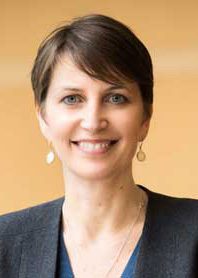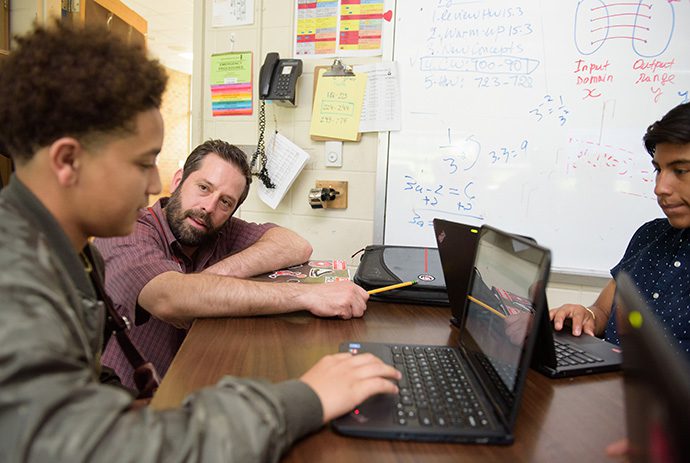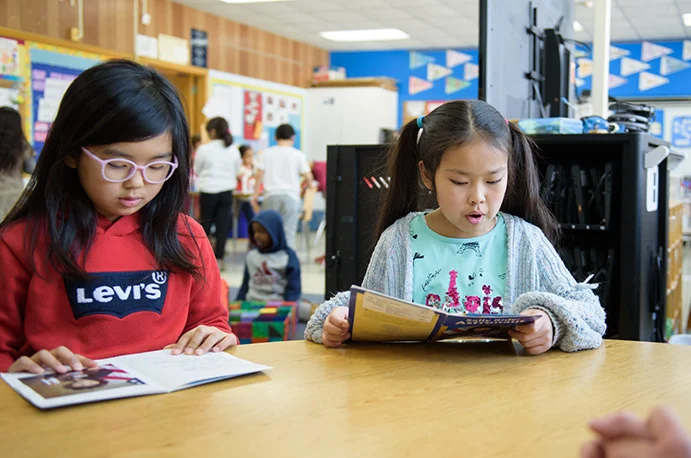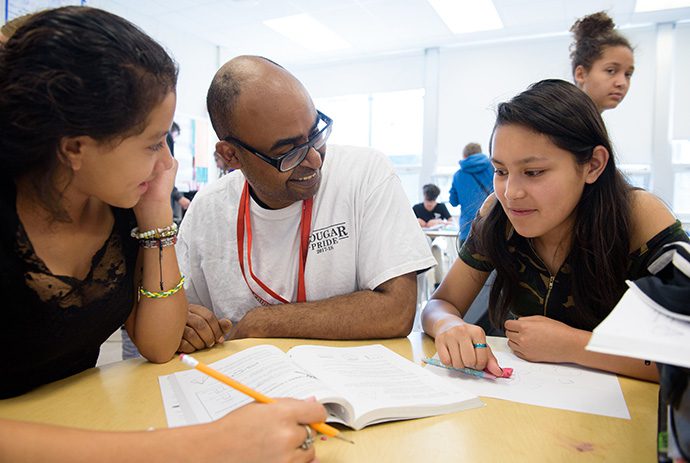
 In this latest installment of The Throughline, Max Silverman speaks with Superintendent Jennifer Cheatham about how to create deep and rich student-centered learning experiences, as well as meaningful professional development for teachers in a school system approach based on equity.
In this latest installment of The Throughline, Max Silverman speaks with Superintendent Jennifer Cheatham about how to create deep and rich student-centered learning experiences, as well as meaningful professional development for teachers in a school system approach based on equity.
Jennifer Cheatham is the superintendent of the 27,000-student Madison Metropolitan School District in Wisconsin. Cheatham specializes in creating systemic improvements in urban districts through the development of instructional alignment and coherence at all levels of a school system. Previously, Cheatham was the chief of instruction for the Chicago Public Schools, leading the central office team to support schools in instructional improvement and was the executive director of curriculum and instruction for the San Diego City Schools.
Max Silverman: When you walk into a classroom or learning environment that is inclusive, engaging and leads to student ownership of learning, what are you looking for? What do you expect to see and hear?
“I want to see evidence that the classroom functions as a community of learners.”
Jennifer Cheatham: I want to see evidence that the classroom functions as a community of learners. I love the community of practice concept. By definition, a community of practice is not only a group that is seeking to solve a problem or explore a passion, but they do so by interacting with one another in a meaningful way. For students, that means they need to understand more than what the objective is for a single content-standard-aligned lesson, but what their collective “why” is — what they’re striving to understand through their collective effort.

I like seeing structured opportunities for students to explore what they’re trying to learn together collectively, but I also love seeing unstructured opportunities — they seem just as important. The unstructured opportunities can give a teacher insight into what a student is capable of that the structured opportunities might not. In a community of practice, there has to be a deep level of trust which requires ongoing trust-building in the classroom. The classroom should be a humanizing space. I also look for the presence of metacognitive conversations — learning about learning and continually unpacking our own thinking and our own struggles.
Max Silverman: To build on that, pick any grade level or subject area and sketch a picture of what that looks like when you actually walk into a classroom where this is happening.
Jennifer Cheatham: I’m going to imagine my son’s first-grade classroom, which is already a warm and nurturing learning environment. In a typical first-grade classroom, at least in the Madison school district where I work, class begins with a morning meeting or circle where they greet one another and invite one another into the day. In a community or practice, that space would be fully leveraged as an opportunity to talk about students’ common concerns, the problems they are trying to solve, and the things they’re passionate about. For a group of first graders, it could be learning how to read — students would talk there about why their collective effort is so important and about why reading is something worth being passionate about.

Max Silverman: And I could picture them first articulating why they want to read or what they want to read.
Jennifer Cheatham: Yes. And they could also articulate what’s scary about it or what they’re worried about, what’s been hard about it and what’s not so hard. This could be an amazing space for them to talk about their joint purpose and collective why, to become metacognitive together and support one another. Primary teachers are already so wonderfully talented at both guided and independent reading experiences. They use them to seek information about students’ cognitive development as well as their interests and passions. For first graders, even the reading journal could be leveraged in new ways, to extend and deepen the classroom experience, bringing the family into the community of learners perhaps.
Max Silverman: Do students and teachers want this type of learning?
Jennifer Cheatham: Last year I went on a listening and learning tour. I wanted to get into richer conversations with students, families, and staff members to better understand what they wanted in their classroom and school experiences. I asked often, “What should a classroom look like, sound like, be like?” I was so moved and a bit stunned by what I heard. What I heard from everyone was a craving for deep and rich learning experiences. I heard from students and families of color that they wanted cultural representation and historically accurate curricula. But it didn’t end there. They wanted representation and historical accuracy so that they could better make sense of, interrogate and challenge the world around them. I think that’s beautiful.
Max Silverman: As a teaching profession, what do we need to pay attention to so that we can create more environments like the ones you are talking about?
“As a profession, we need to move beyond simply creating instructional coherence.”
Jennifer Cheatham: There are a few things. As a profession, we need to move beyond simply creating instructional coherence. I spent much of my career trying to create instructional coherence — which is important. I’ve grown up in the standards movement and have been striving to align curriculum and instruction, assessment, intervention, and reporting systems. But it is supremely limiting. Instructional coherence is important, but it should only be used as a foundation for us to strive for deep and rich learning experiences for students. Creating a coherent system around shallow learning experiences is probably not worth the time and energy. But how do you scale deep and rich learning experiences across classrooms and schools? This is the next level of work for us all.
“Instructional coherence is important, but it should only be used as a foundation for us to strive for deep and rich learning experiences for students.”
When I talk to teachers, the things they express frustration about are often instructional design challenges: the decisions we make about who is teaching which students in what environments at what time. The way we design the school day can either help or hurt a teacher’s ability to create the kind of humanizing spaces we want in our classrooms.
Max Silverman: You could design the most beautiful standards-based task and not create that sort of learning environment for kids you’re talking about.
Jennifer Cheatham: Instructional design, if you do it well, should be unapologetically student-centered. Last year some middle schoolers told me how jarring it was for them to walk down the hallway in between classes. Every 50 minutes they have to walk down this crowded hallway and it takes them some time just to center before they can be ready to learn again. It’s a really basic example, but this is an instructional design challenge. Are we thinking intentionally about the entirety of the school day — after school experiences, community experiential learning, intentional exploration of college and career options? That is all a critical part of instructional design. We need instructional designs that set up our teachers and our students for more success.

When it comes to instruction, we also have to do explicit work on race, implicit bias, and white fragility. If teachers are going to create the kind of humanizing spaces we’re talking about, every educator has to do their own internal work on racial identity and every educator has to learn about the history of race in our country. Without this intentional effort, we won’t be able to develop the empathic mindsets necessary to build community in classrooms.
Max Silverman: You’re laying out a pretty heavy agenda. What does educational leadership look like that can support and grow and develop teachers to be able to do these things?
Jennifer Cheatham: First, the principal as instructional leader has sometimes been interpreted as an expert at instruction who goes around giving feedback to teachers and planning all their professional development. Instead, I see the principal as an orchestrator of networks and connections to build the community of practice. All the things that I described wanting desperately for students in their classrooms, I want the same thing for teachers. I want teachers to function in communities of practice and have opportunities for trust and rapport-building. I want them to explore the things they’re most passionate about or concerned about. There needs to be symmetry between what students get in a classroom and what teachers are getting professionally.
“All the things that I described wanting desperately for students in their classrooms, I want the same thing for teachers.”
We need to learn what it looks like to lead with more humanity ourselves — how do we build in time to breathe, and opportunities for mindfulness and to care for one another. Leaders also have to become more adept at creating the environments necessary for teachers, who are still primarily white and female, to talk about race in ways that will help us move this vision for instruction forward and without shutting down. It’s our obligation as educators to be anti-racist educators. That’s a critical component for any future leader in education.
Max Silverman: In your ideal world, what is the role of the school system central office when supporting student learning, classroom teaching and school leadership?
Jennifer Cheatham: The central office plays a critical role, as do those of us who are superintendents. I’ve tried to help the central office get clear on the work they are best positioned to do in service of schools. What resources do we need to be able to provide for schools that don’t already exist or that they can’t themselves create? What consultation might we provide that they critically need, but they wouldn’t find within the school building? The central office has to think hard about what we can do to clear the path so schools can focus on the things that are most important. That may include getting rid of institutional barriers that stand in the way.
The things that are most difficult for me to address now are the things that have just gone unattended to for far too long. What happens when you’re not thinking long term about early childhood in your community? What happens when you haven’t paid attention to high-needs neighborhoods and the resources and services needed so families can be plugged into school in a meaningful way? What happens when you haven’t taken care of your school buildings? Superintendents change, board members change, mayors change. But the community remains, so if we’re not thinking long term, that’s a disservice to the community that you serve.
My other thought is about processes for continuous improvement and problem-solving. The central office plays a critical role in building people’s capacity to use processes for continuous improvement, and accountability. But I’m learning that when you’re leading in these enormously complex environments, we have to learn how to introduce new processes, depending on what it is that we’re trying to solve.
Max Silverman: You paint a very proactive, strategic, “leaderly” type of central office. What does it look like to be a more humanistic leader and grapple with issues of race and equity?
“I have spent the last decade figuring out what it looks like to be a true ally and co-conspirator with students, families and staff of color.”
Jennifer Cheatham: About a decade or so ago, I realized I was not using my privilege as a white leader to enact change that would benefit people who don’t have the same privileges. I was not yet taking the kind of risks I needed to be taking. I have spent the last decade figuring out what it looks like to be a true ally and co-conspirator with students, families and staff of color. I’ve had to do a lot of internal work, and continually invite feedback from friends, colleagues and even strangers. I need to know if my actions, my words, are ever getting in the way of progress. As a white, female instructional leader I feel especially obligated — in a field that is dominated by white women — to talk about our obligation as educators to be anti-racist. I feel especially obligated to lead in that manner.
Max Silverman: Jennifer, thank you so much. It’s been a great honor having you here.
Jennifer Cheatham: The honor is mine.
Photos used with permission from Madison Metropolitan School District. All rights reserved.

